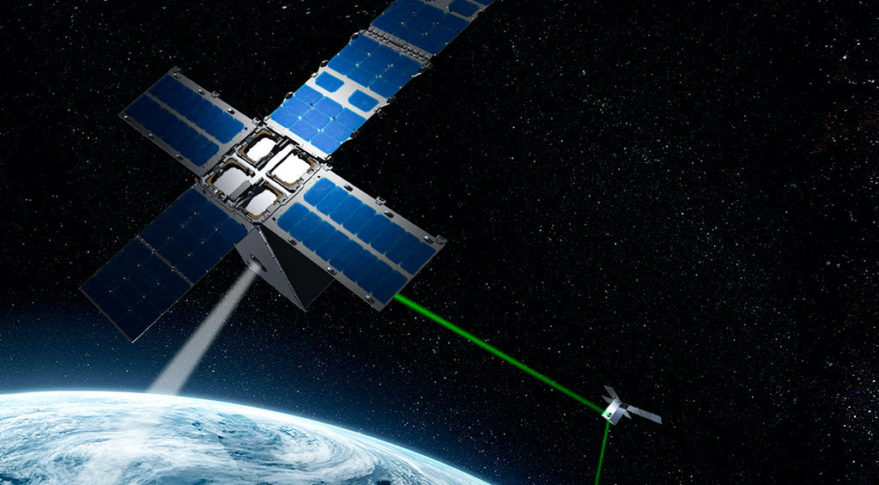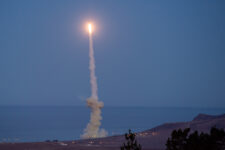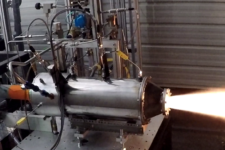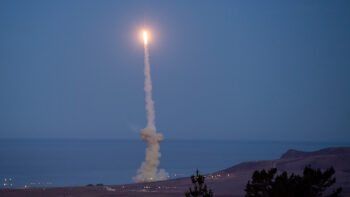
Satellite crosslinks using lasers are key to the Space Development Agency’s LEO-based architecture. (SDA image)
WASHINGTON — Space Development Agency (SDA) Director Derek Tournear announced today that the agency has successfully demonstrated the ability of its optical communications terminals to link satellites together — a capability that he has acknowledged as the longest pole in the tent for its planned mesh network of data transport and missile warning/tracking satellites in low Earth orbit (LEO).
“To date,” he told the annual Defense News conference, “we had not demonstrated laser communication, to be able to do that and form that network — that’s what I was prepared to come in here and say. But last night, we actually demonstrated it.”
The on-orbit demonstration involved laser light terminals, built by German firm TESAT, carried on two of the four missile warning/tracking satellites built by SpaceX and launched last year as part of SDA’s initial, experimental constellation called Tranche 0, Tournear explained.
“They were able to demonstrate that they could, in fact, do the laser communication. They maintained link, they acquired link. The requirement in our optical comm standard is that it takes you less than 100 seconds to acquire a link during pointing, acquisition and timing, with like a stretch goal of less than 10 seconds. They were well under the 100 seconds, but they were over the 10 seconds, and they maintained that link for several hours,” he elaborated.
Optical intersatellite links are key to SDA’s grand plan for a Proliferated Warfighter Space Architecture that would network its hundreds of LEO birds to myriad other military satellites and eventually integrate commercial satellites across orbits, Tournear explained.
For example, he said, SDA is planning to use “translator satellites” — or “space exchange points” as the Space Force has “rebranded” them — to connect its Tracking Layer birds to the Space Force’s resilient missile warning/tracking constellation in medium Earth orbit.
The agency also is in talks with commercial vendors about how use the “hybrid” communications terminals on the translator birds to bring their constellations into the mix, Tournear said. The vendors he mentioned include SpaceX and Amazon regarding their respective Starlink and Kuiper broadband (i.e. Internet) communications satellites, space-based intelligence, surveillance and reconnaissance providers Capella, Planet and Maxar Intelligence.
Tuesday’s demo of intersatellite laser links was the final success in a trifecta of baseline technical challenges that have been facing SDA, Tournear stressed.
“From my perspective, we have demonstrated all of the big rocks and burn down all of the risk for Tranche 1 in Tranche 0, based on that success last night,” he said.
The first big test was of the agency’s 19 Tranche 0 Transport Layer satellites now on orbit designed for low latency, high-bandwidth communications to use the military’s venerable Link 16 data link to transmit information to ground-, air- and sea-based platforms. The Transport Layer satellites are being built as a critical node in the Pentagon’s ambitious plans for Joint All Domain Command and Control.
SDA passed that test in November 2023 by successfully sending signals to ground-based radios based outside the US due to a continuing tussle with the Federal Aviation Administration (FAA) over the safety of using space-based Link 16 over US territory where it might disrupt civilian air traffic radar.
While SDA officials up to now have been coy about which US ally had hosted the Link 16 demo, Tournear today revealed that the test took place in Australia. He also noted that similar downlinks were conducted to a US Navy aircraft carrier in international waters — as well as to a plane on its deck, a feat that he said “is actually more difficult than if it were actually flying.”
Tournear added that SDA is now looking to do “some future tests” with Norway, as the agency continues to wait for the Defense Department and the US Navy (which has the lead in the process) to certify to the FAA that the Link 16 radios on its satellites will not cause interference with civilian systems. “It is a very long process,” he said.
The second challenge to be overcome, Tournear said, was “can you, in fact, do the missile tracking mission from LEO?” He explained that “there was a lot of debate” on the ability to keep tabs on a dim, fast-flying missile in the “cluttered” LEO environment when the satellites themselves are “screaming across” the horizon.
“We demonstrated that successfully,” he said. We’ve been able to detect a lot of different missile launches. We’ve been able to detect rocket launches. We were able to detect the Starship reentry, a lot of activity.”
Starship is the extremely heavy launch vehicle being developed by SpaceX for NASA missions to the Moon and eventually Mars — with the Space Force also eyeing the launcher for ferrying cargo to and from far-flung theaters. SpaceX successfully demonstrated Starship’s ability to reenter the Earth’s atmosphere during its fourth test of the vehicle in June.
However, Tournear said SDA’s Tracking Layer satellites still haven’t been able to track a “blue” hypersonic missile flight, not because of any technical issues but merely because of the inability to find a window of opportunity when the four SpaceX birds now operational would be in position to do so. There are four more missile warning/tracking satellites built by L3Harris on orbit, but they “are still going through test and checkout,” he said, adding that SDA expects to start collecting data from those sometime this month.
The next step for SDA is to begin launching its next set of Transport Layer and Tracking Layer satellites, called Tranche 1 and capable of providing initial operational capability to warfighters, around the end of this calendar year — having missed its original goal to get those up by this month.
“We will launch around the end of this calendar year, whether that’s on this side of the calendar year or the next side of the calendar year is TBD,” he said. “There’s still some risk in that schedule.”





















